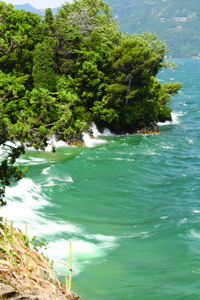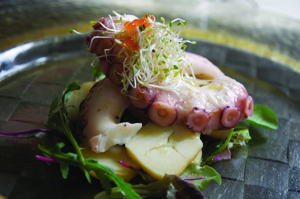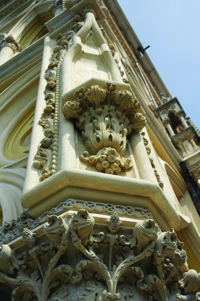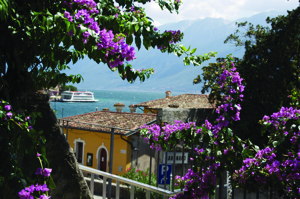Sally FitzGerald takes in the sights and sounds of the Brescia province, from the majestic attractions of southern Lake Garda to the hidden gems of the provincial capital city…
 “We will go straight to the island. We must be faster than the storm.” If I?m being honest these aren?t the first words I am hoping to hear as I climb aboard the 60-person boat at Gargnano harbour for a picturesque ride around the southern waters of Lake Garda. Sadly the torrential rain has decided to join us and brought with it plenty of thunder and lightening. I arrived in Lake Garda the evening before to a stifling, humid heat but as the sunshine gave way to flashes of lightening I had soon discovered that the lake has its own microclimate and these dramatic storms are a natural result, turning the usually tranquil waters into a fractious beast.
“We will go straight to the island. We must be faster than the storm.” If I?m being honest these aren?t the first words I am hoping to hear as I climb aboard the 60-person boat at Gargnano harbour for a picturesque ride around the southern waters of Lake Garda. Sadly the torrential rain has decided to join us and brought with it plenty of thunder and lightening. I arrived in Lake Garda the evening before to a stifling, humid heat but as the sunshine gave way to flashes of lightening I had soon discovered that the lake has its own microclimate and these dramatic storms are a natural result, turning the usually tranquil waters into a fractious beast.
Unable to see the other side of the lake through the thick veil of cloud I hold on tight as Captain Arnold expertly reads the waves, steering the boat safely through the calmest path to our first destination of the day ? the breathtaking Isola del Garda. On approach to the island you could be mistaken for thinking that you are merely in for a stroll around the rich gardens that seem to stretch for miles but as we edge our way around the rocky coastline a majestic dusty yellow structure comes into view. For a moment I forget the rocking of the boat and stand up to get a better look. A sprawling Venetian-style palace emerges with endless terraces and arches adorning its fa?ade. It?s like something out of a fairytale.
Docking at a small harbour on the edge of the gardens we are ushered over to meet Alberta, a charming woman who lives on the island alongside her mother, two of her brothers and their families. The island has seen many uses over the years from being the site of a Franciscan school to a haven for passing fishermen when the lake was in its worst moods. It was finally given to Duke Gaetano De Ferrari ? Alberta?s ancestor ? in 1870. De Ferrari spent many years transforming the island and its building into what we see today, constructing a large neo-gothic Venetian palace and enhancing the neglected garden with exotic tropical plants. The family then decided to open up parts of the island to guided tours in 2001 to help pay for the inevitable restoration work that buildings of this grandeur require.
Alberta guides us around the gardens, first proudly showing us the different aspects, from the dense tall forest areas to the more delicate English cottage garden, which her English-born mother developed to remind her of her homeland. The familiar scents of roses and hydrangeas envelop us as we stop for a moment to look up at and admire the vibrant purple shade of bougainvillea creeping up the sides of the palace.
As the gardens open up to reveal the ancestral home, Alberta takes us on a brief tour of the majestic building. Like a living museum, everywhere you look lies a beautiful artifact begging to tell you its part in the fascinating family history. From vases belonging to Russian members to toys from the Irish side and even a picture of the ancestor that was once a pope, it all adds to the beauty of the property and shows that this is still a much-loved home, not just an old house turned museum.
SEASIDE DELIGHTS
All too quickly it is time to leave and I am reluctant to bid goodbye to the island as we board the boat back to the mainland ready to continue our sightseeing. Our lunch stop is in Sirmione del Garda and when we get there I am struck by how different this town is to Isola del Garda, and indeed Gargnano where I am staying. Suddenly we are surrounded by people, thousands of them. Located on a long peninsula that juts 4km out into the lake, Sirmione has a reputation for being the ideal place for soaking up the sun on the small beaches, practising water sports on the lake or spending a couple of hours perusing the plethora of tourist-themed shops and ice-cream parlours. The narrow streets may pulse with visitors, but once you delve a little deeper you will discover a town with a rich history that?s accessible through its Rocca Scaligera castle and many historic thermal baths.
 We settle ourselves into Ristorante Il Girasole which sits alongside one of the town?s quieter streets. Mealtimes in Garda generally mean one thing ? a feast of fish and seafood for almost every course. The lake itself harbours many different breeds and what can?t be found on the lake is transported from the nearby sea. From sardines and mussels to perch and swordfish, you can find it all. This time we opt for a meaty octopus antipasti followed by sea bass with potato puree: the perfect marriage of land and sea. To round off the meal we indulge in the house trio of desserts ranging from hot chocolate pudding to tiramisu and a refreshing lemon sorbet with vodka.
We settle ourselves into Ristorante Il Girasole which sits alongside one of the town?s quieter streets. Mealtimes in Garda generally mean one thing ? a feast of fish and seafood for almost every course. The lake itself harbours many different breeds and what can?t be found on the lake is transported from the nearby sea. From sardines and mussels to perch and swordfish, you can find it all. This time we opt for a meaty octopus antipasti followed by sea bass with potato puree: the perfect marriage of land and sea. To round off the meal we indulge in the house trio of desserts ranging from hot chocolate pudding to tiramisu and a refreshing lemon sorbet with vodka.
Lunch finished, we travel to Gardano on the opposite side of the lake for our afternoon activity – exploring Museo Amici del Vittoriale, the house of infamous poet, playwright, war hero and all-round eccentric Gabriele D?Annunzio. D?Annunzio played a varied part in Italian history, acting as a member of parliament and taking part in WWI at the age of 50! During the war he decided that Fiume in Croatia should become a part of Italy and so organised his own army to take control of the area in September 1919. In December 1920 he was eventually forced to surrender power by the Italian government and was exiled to Lake Garda to build a life away from politics. D?Annunzio bought a country house in Gardano and transformed it into a grand house with sprawling gardens.
On a tour of the light-starved rooms you get an insight into D?Annunzio?s real eccentricities. The house is crammed with objects ? over 10,000 of them in total. D?Annunzio said that he loved to be surrounded by beauty and the bathroom alone houses 900 items including about 50 brushes and combs, which is ironic as the man was actually bald! Other rooms reveal that he lived by his belief that there were only five Deadly Sins ? in his world lust and greed did not count.
For me the most amazing room is the Leper?s Room, which he designed around what would become his funeral bed. The bed is made up of two elements ? one side a cradle and the other a coffin, while a picture of D?Annunzio in the guise of a leper watches over the bed. In the 19th century it was suggested lepers had been touched by God and D?Annunzio thought the same. He treasured power above all else and wanted the power to control how people should view him always, even on his deathbed.
I discover that his eccentricity even extends into the house?s grounds as we explore the large three-tiered mausoleum which contains his remains and the large battleship ?Puglia? which was given to him in 1923 by the Italian navy and he put it in his garden pointing out towards the Adriatic Sea ready to sail!
UNCOVERING A HIDDEN GEM
 The next morning I awake to a much calmer Lake Garda, wishing our boat trip had been re-arranged for today. Instead we are off to explore the city of Brescia. Brescia is a province in the Lombardy region which includes the western and southern areas of Lake Garda as well as many towns and cities further inland. The capital city of the province, also called Brescia, has become most famous for hosting the start and finish of the iconic Mille Miglia car race since 1927. As we approach the sleepy streets I realise that apart from during the race season the city pretty much remains untouched by tourists, so we will be able to explore unhindered.
The next morning I awake to a much calmer Lake Garda, wishing our boat trip had been re-arranged for today. Instead we are off to explore the city of Brescia. Brescia is a province in the Lombardy region which includes the western and southern areas of Lake Garda as well as many towns and cities further inland. The capital city of the province, also called Brescia, has become most famous for hosting the start and finish of the iconic Mille Miglia car race since 1927. As we approach the sleepy streets I realise that apart from during the race season the city pretty much remains untouched by tourists, so we will be able to explore unhindered.
Our first stop is the Santa Giulia city museum which was declared a UNESCO World Heritage Site in 2011. Housed in the Benedictine nunnery of San Salvatore and Santa Giulia, which was founded in 753, it is the kind of museum you can easily get lost in as you traverse the rabbit warren-style rooms and find that the morning has quickly slipped away without you noticing.
Moving on we stumble upon the churches of Santa Giulia and San Salvatore, equally impressive in their levels of preservation, with colourful frescoes, intricate knotwork adorning stone archways, and eerily-lit crypts.
ESCAPING THE CROWDS
Deciding it?s time to leave, we head outside to explore the rest of the city and just a few hundred meters down the road we turn the corner to find the remains of an imposing Corinthian temple and amphitheatre. There are no great crowds gathered around to explore the site, we can spend our time and peruse as we please.
 Before we leave we have one last speciality of the city to enjoy ? Aperol Spritz. Sitting in Piazza della Loggia overlooking the Town Hall we join the locals in ordering glasses of the orange-hued aperitivo. Undaunted by the colour I take my first sip. Heaven. The combination of sparkling wine, soda water and Aperol liqueur creates a refreshing tipple that is sweet without being sickly.
Before we leave we have one last speciality of the city to enjoy ? Aperol Spritz. Sitting in Piazza della Loggia overlooking the Town Hall we join the locals in ordering glasses of the orange-hued aperitivo. Undaunted by the colour I take my first sip. Heaven. The combination of sparkling wine, soda water and Aperol liqueur creates a refreshing tipple that is sweet without being sickly.
Eventually we head back to Lake Garda to spend our last evening in Limone, the town famous for its lemons and lemon houses. It?s a popular location with tourists which we see from the number of families taking an evening stroll by the lakeside. The area is alive with the gentle buzz of voices while the occasional musical interlude seeps out from the many restaurants.
By the time we?ve reached dessert ? lemon semifreddo covered in a zingy lemon jelly ? the heat of the day has tempted the storms to return and flashes of lightening illuminate the southern end of the lake. The storm is in full force when we get back to our hotel but this time I find it somewhat comforting as I lie in bed, my room illuminated by nature?s very own firework display.
GETTING THERE
By plane: The closest airports offering flights to and from the UK are Verona and Bergamo, 45-minute drives away, but flying into Milan, about one and a half hour?s drive, will give you a better choice of departure airports. Good shuttle bus services serve Brescia from the airports. Expect to pay between ?15 and ?35.
By train: Most trains going between Milan and Venice stop at Brescia train station. Brescia is about 45 minutes from Verona, an hour from Milan and and two hours from Venice. For timetable and ticket information visit, www.fs-online.it
By car: Brescia is easily accessed by car on the A4 from Milan or Venice. Alternatively, you can take the A21 from Cremona. The Statale Goitese and Statale Asolana also lead into Brescia.
